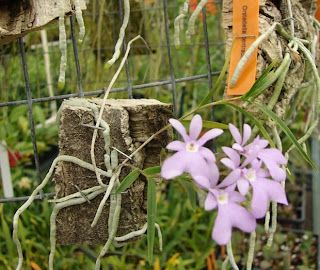I did find a similar plant on rv-orchids.com, link here. Even more, this link from "the lush garden within", a blog on wordpress.com. More here. Due to copyright issues, I'm not copying those images, just linking. This does look like "Jovie's Orchid".
 Image from wikimedia commons. This is identified as "Oerstedella centropetala"
Image from wikimedia commons. This is identified as "Oerstedella centropetala"Hborchids.com describes these are winter blooming orchids. More information from Yongee.name "warm to intermediate-growing species native to Nicaragua, Costa Rica and Panama... grows at low elevations in wet montane forests on the Pacific slopes... 1,400 m altitude...wet and dry seasons succeed each other... also really good pic on species-specific.com, stating that these orchids grow in heavy shade. That would be good for an indoor plant. That site states these bloom in Spring.
_-_Xenia_vol_1_pl_17_(1858)%5B1%5D.jpg)
_-_Xenia_vol_1_pl_17_(1858)%5B1%5D.jpg)
Old sketch illustrating similar plant, also from wikimedia commons, labeled "Oerstedella centradenia and Oerstedella centropetala / Epidendrum centropetalum".
As with all things ortchid, "We'll see" is the appropriate concept. This may or may not turn out to be the correct ID, but it's interesting to learn about all orchids.
As with all things ortchid, "We'll see" is the appropriate concept. This may or may not turn out to be the correct ID, but it's interesting to learn about all orchids.

